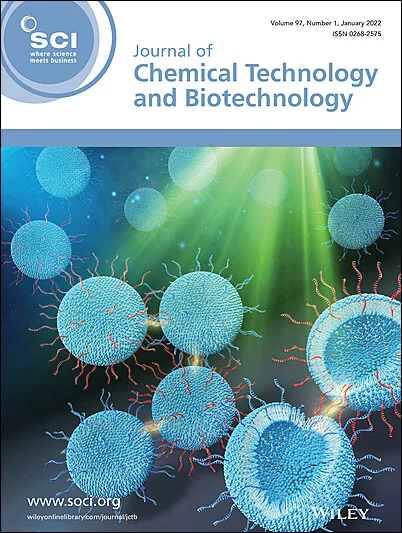Fritz E. Vorisek, Yaying Ji, Jesse Thompson, Kunlei Liu, Mark Crocker
求助PDF
{"title":"CO2捕集与微藻培养的一体化:以氨气为氮源的室外尖茅养殖示范评估","authors":"Fritz E. Vorisek, Yaying Ji, Jesse Thompson, Kunlei Liu, Mark Crocker","doi":"10.1002/jctb.7824","DOIUrl":null,"url":null,"abstract":"<div>\n \n \n <section>\n \n <h3> Background</h3>\n \n <p>Towards the goal of integrating CO<sub>2</sub> capture using aqueous ammonia with its utilization for algae cultivation, <i>Scenedesmus acutus</i> (UTEX B72) was grown in 1100 L open raceway ponds using CO<sub>2</sub> and NH<sub>3</sub> supplied from gas cylinders. CO<sub>2</sub>/NH<sub>3</sub> mole ratios of 7 and 10 were employed, the gas mixture acting as a surrogate for the output from a CO<sub>2</sub> scrubbing system using aqueous ammonia.</p>\n </section>\n \n <section>\n \n <h3> Results</h3>\n \n <p>Compared to <i>Scenedesmus acutus</i> grown in open ponds using gaseous CO<sub>2</sub> and NaNO<sub>3</sub> as the N-source, the ponds supplied with gaseous CO<sub>2</sub> and NH<sub>3</sub> displayed higher productivity at both CO<sub>2</sub>/NH<sub>3</sub> ratios, with the higher ratio providing the best growth. Depending on the culturing conditions and CO<sub>2</sub>/NH<sub>3</sub> ratio, CO<sub>2</sub> utilization ranged up to 15.8% and NH<sub>3</sub> utilization to 23.0%. These rather low values reflect the fact the high CO<sub>2</sub>/NH<sub>3</sub> feed rate used, resulting in a substantial release of NH<sub>3</sub> from the ORPs (~45%).</p>\n </section>\n \n <section>\n \n <h3> Conclusions</h3>\n \n <p>These findings demonstrate the suitability of gaseous NH<sub>3</sub> as a N-source for microalgae cultivation, while highlighting the need for a control strategy that closely balances the CO<sub>2</sub>/NH<sub>3</sub> supply with the algae growth rate. The produced algae biomass possessed a high protein and low ash content, rendering it particularly suitable for use as a bioplastic feedstock. © 2025 Society of Chemical Industry (SCI).</p>\n </section>\n </div>","PeriodicalId":15335,"journal":{"name":"Journal of chemical technology and biotechnology","volume":"100 4","pages":"858-864"},"PeriodicalIF":2.8000,"publicationDate":"2025-02-07","publicationTypes":"Journal Article","fieldsOfStudy":null,"isOpenAccess":false,"openAccessPdf":"","citationCount":"0","resultStr":"{\"title\":\"Integration of CO2 capture and microalgae cultivation: demonstration assessment of outdoor Scenedesmus acutus cultivation using gaseous ammonia as a nitrogen source\",\"authors\":\"Fritz E. Vorisek, Yaying Ji, Jesse Thompson, Kunlei Liu, Mark Crocker\",\"doi\":\"10.1002/jctb.7824\",\"DOIUrl\":null,\"url\":null,\"abstract\":\"<div>\\n \\n \\n <section>\\n \\n <h3> Background</h3>\\n \\n <p>Towards the goal of integrating CO<sub>2</sub> capture using aqueous ammonia with its utilization for algae cultivation, <i>Scenedesmus acutus</i> (UTEX B72) was grown in 1100 L open raceway ponds using CO<sub>2</sub> and NH<sub>3</sub> supplied from gas cylinders. CO<sub>2</sub>/NH<sub>3</sub> mole ratios of 7 and 10 were employed, the gas mixture acting as a surrogate for the output from a CO<sub>2</sub> scrubbing system using aqueous ammonia.</p>\\n </section>\\n \\n <section>\\n \\n <h3> Results</h3>\\n \\n <p>Compared to <i>Scenedesmus acutus</i> grown in open ponds using gaseous CO<sub>2</sub> and NaNO<sub>3</sub> as the N-source, the ponds supplied with gaseous CO<sub>2</sub> and NH<sub>3</sub> displayed higher productivity at both CO<sub>2</sub>/NH<sub>3</sub> ratios, with the higher ratio providing the best growth. Depending on the culturing conditions and CO<sub>2</sub>/NH<sub>3</sub> ratio, CO<sub>2</sub> utilization ranged up to 15.8% and NH<sub>3</sub> utilization to 23.0%. These rather low values reflect the fact the high CO<sub>2</sub>/NH<sub>3</sub> feed rate used, resulting in a substantial release of NH<sub>3</sub> from the ORPs (~45%).</p>\\n </section>\\n \\n <section>\\n \\n <h3> Conclusions</h3>\\n \\n <p>These findings demonstrate the suitability of gaseous NH<sub>3</sub> as a N-source for microalgae cultivation, while highlighting the need for a control strategy that closely balances the CO<sub>2</sub>/NH<sub>3</sub> supply with the algae growth rate. The produced algae biomass possessed a high protein and low ash content, rendering it particularly suitable for use as a bioplastic feedstock. © 2025 Society of Chemical Industry (SCI).</p>\\n </section>\\n </div>\",\"PeriodicalId\":15335,\"journal\":{\"name\":\"Journal of chemical technology and biotechnology\",\"volume\":\"100 4\",\"pages\":\"858-864\"},\"PeriodicalIF\":2.8000,\"publicationDate\":\"2025-02-07\",\"publicationTypes\":\"Journal Article\",\"fieldsOfStudy\":null,\"isOpenAccess\":false,\"openAccessPdf\":\"\",\"citationCount\":\"0\",\"resultStr\":null,\"platform\":\"Semanticscholar\",\"paperid\":null,\"PeriodicalName\":\"Journal of chemical technology and biotechnology\",\"FirstCategoryId\":\"5\",\"ListUrlMain\":\"https://onlinelibrary.wiley.com/doi/10.1002/jctb.7824\",\"RegionNum\":4,\"RegionCategory\":\"生物学\",\"ArticlePicture\":[],\"TitleCN\":null,\"AbstractTextCN\":null,\"PMCID\":null,\"EPubDate\":\"\",\"PubModel\":\"\",\"JCR\":\"Q3\",\"JCRName\":\"BIOTECHNOLOGY & APPLIED MICROBIOLOGY\",\"Score\":null,\"Total\":0}","platform":"Semanticscholar","paperid":null,"PeriodicalName":"Journal of chemical technology and biotechnology","FirstCategoryId":"5","ListUrlMain":"https://onlinelibrary.wiley.com/doi/10.1002/jctb.7824","RegionNum":4,"RegionCategory":"生物学","ArticlePicture":[],"TitleCN":null,"AbstractTextCN":null,"PMCID":null,"EPubDate":"","PubModel":"","JCR":"Q3","JCRName":"BIOTECHNOLOGY & APPLIED MICROBIOLOGY","Score":null,"Total":0}
引用次数: 0
引用
批量引用

 求助内容:
求助内容: 应助结果提醒方式:
应助结果提醒方式:


